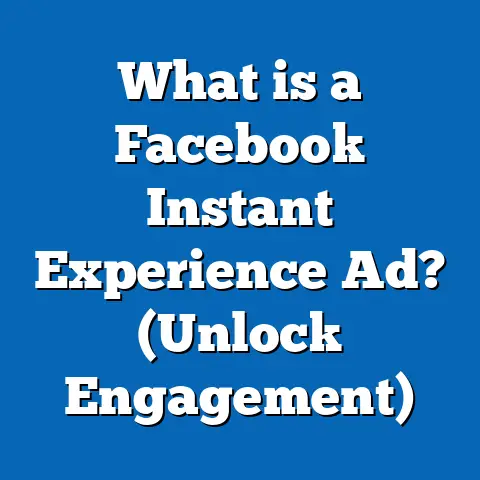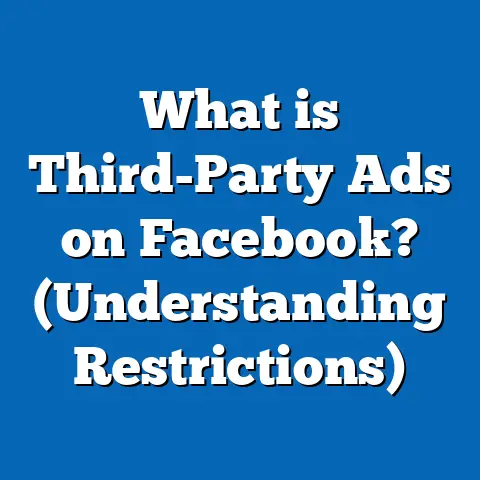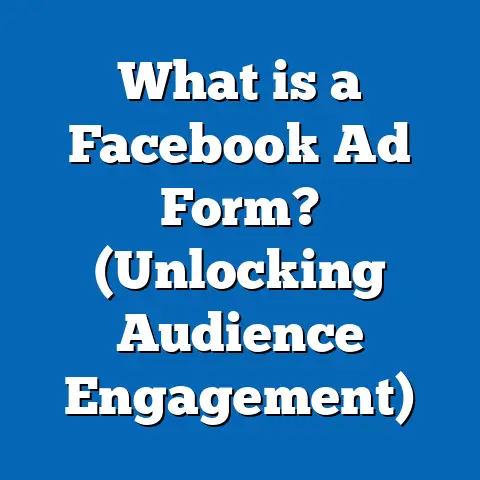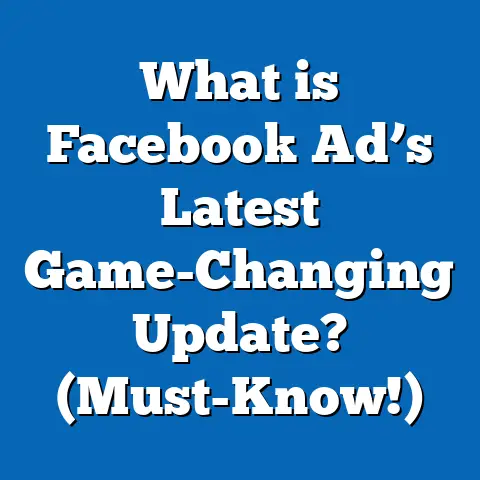What is Facebook Partnership Ads? (Unlocking Collaborative Growth)
Introduction
In the ever-evolving landscape of digital marketing, businesses strive to find advertising solutions that are both cost-effective and high-impact. The ease of managing digital campaigns has never been greater, yet the challenge remains to capture audience attention in a crowded marketplace. Facebook, as one of the largest social media platforms globally, continues to innovate advertising tools that help marketers optimize their efforts.
One such innovation is Facebook Partnership Ads, a collaborative advertising format designed to unlock new growth avenues through strategic partnerships. This feature allows brands and businesses to co-create and co-promote ads, leveraging each other’s strengths for mutual benefit.
Understanding Facebook Partnership Ads
What Are Facebook Partnership Ads?
Facebook Partnership Ads are a type of collaborative advertising where two or more businesses work together to create and run joint ad campaigns on Facebook’s platform. Unlike traditional solo campaigns, partnership ads allow businesses to pool their resources — from budget to creative assets — and target combined or complementary audiences.
This partnership promotes shared growth by:
- Combining brand awareness efforts,
- Sharing advertising costs,
- Gaining access to new audience segments,
- Sharing data insights for better campaign optimization.
Why Facebook Introduced Partnership Ads
Facebook’s introduction of Partnership Ads responds to shifts in marketing dynamics:
- Consumer Trust: Collaborations between trusted brands enhance credibility.
- Ad Fatigue: Fresh, co-branded content appeals better to audiences tired of repetitive ads.
- Cost Pressures: Shared budgets reduce financial barriers for smaller businesses.
- Data-Driven Marketing: Joint data insights improve targeting precision.
According to Facebook’s Q4 2023 advertising report, campaigns involving partnership ads generated on average 27% higher click-through rates (CTR) compared to standard solo ads.
Key Terminology
| Term | Definition |
|---|---|
| Partner Business | A company or brand that collaborates with another to run joint ad campaigns. |
| Business Manager | Facebook’s tool for managing ad accounts, Pages, and permissions across organizations. |
| Custom Audiences | Targeted groups created from customer data or engagement history. |
| Lookalike Audiences | New audiences similar to an existing one based on behavior or demographics. |
| Ad Account Roles | Permissions assigned to users managing ads in Facebook Business Manager. |
The Evolution of Collaborative Advertising on Facebook
Early Collaborative Advertising Tools
Facebook first allowed collaboration in advertising through Branded Content Ads. These enabled influencers or publishers to tag brands in organic posts, which then could be promoted with paid ads. However, this was limited to influencer marketing scenarios without full ad account integration.
Transitioning to Co-Branded Campaigns
Brands began experimenting with co-branded ads independently by sharing creative assets but faced challenges in aligning budgets and measuring combined performance accurately.
Introduction of Partnership Ads
Facebook Partnership Ads were introduced in late 2022 as a native collaborative ad format within Facebook Business Manager. This allowed:
- Shared campaign management,
- Joint audience targeting,
- Unified reporting dashboards,
- Built-in cost-sharing mechanisms.
This evolution reflects broader trends in digital marketing emphasizing partnership and data collaboration.
Data Insight: Growth Metrics
- Businesses using Partnership Ads reported a 30% increase in conversion rates (Facebook internal data, 2023).
- Collaborative ads saw a 22% increase in average session duration on linked landing pages.
- 68% of marketers surveyed in 2024 said partnership ads helped them reach new customer segments more effectively.
How Facebook Partnership Ads Work: A Technical Breakdown
Step 1: Establishing the Partnership
To run Partnership Ads, both businesses must:
- Have verified Facebook Business Manager accounts,
- Agree on campaign terms including budget splits,
- Assign roles and permissions to manage the campaign collaboratively.
Step 2: Audience Integration
Partners can share custom audiences securely. For example:
- Brand A shares its customer email list (hashed for privacy).
- Brand B shares its website visitors.
- The combined audiences allow ads to target users familiar with either brand.
Step 3: Creative Collaboration
Both brands jointly develop:
- Ad copy reflecting both brand voices,
- Visual assets combining logos or product images,
- Offers that appeal to both customer bases.
Facebook provides tools for collaborative creative review within Business Manager.
Step 4: Campaign Launch and Optimization
Ads run simultaneously under:
- One consolidated campaign managed jointly,
- Separate placements but under the same targeting parameters,
- Shared budgets configurable by percentage.
Real-time performance data is accessible to all partners via dashboards showing KPIs like impressions, CTR, CPC (cost per click), and conversion metrics.
Step 5: Data Sharing and Compliance
Facebook ensures compliance with privacy regulations such as GDPR and CCPA by:
- Hashing shared customer data,
- Providing consent management tools,
- Allowing partners to control what data is shared.
Benefits of Facebook Partnership Ads Explained
1. Increased Reach and Audience Expansion
By combining audience pools, partnership ads extend reach beyond what either brand could achieve alone. For example:
- A tech gadget company can tap into a lifestyle brand’s audience interested in innovation.
- A local coffee shop can partner with a bakery chain to reach coffee lovers who also enjoy pastries.
Statistic: According to eMarketer 2024 report, campaigns using Partnership Ads see a 29% wider audience reach on average.
2. Shared Advertising Costs Reduce Risk
Pooling budgets means lower individual investment while maintaining high impression volumes. This is particularly beneficial for small-to-medium enterprises (SMEs) with limited ad spend.
Example: Two mid-sized brands split a $20,000 campaign budget rather than each spending $20,000 independently, doubling exposure for half the cost.
3. Enhanced Creative Synergy
Partnerships enable richer storytelling by blending brand strengths:
- Cross-promotions showcasing complementary products,
- Seasonal campaigns featuring bundle offers,
- Co-branded events or contests promoted through ads.
This synergy attracts more engagement by appealing to customers’ broader interests.
4. Access to Combined Data Insights
Sharing campaign performance data allows partners to:
- Identify which creative elements resonate most,
- Understand cross-audience behaviors,
- Refine targeting strategies collaboratively.
This leads to continuous improvement in campaign effectiveness.
Case Studies: In-depth Analysis of Successful Facebook Partnership Ads Campaigns
Case Study 1: Outdoor Gear Brand & Adventure Travel Agency
Background: An outdoor gear company partnered with an adventure travel agency to promote bundled offers – gear plus travel packages.
Objectives:
- Increase bookings for adventure trips.
- Boost sales of outdoor products.
Strategy:
- Jointly developed ads combining imagery of gear and travel destinations.
- Shared custom audiences targeting outdoor enthusiasts.
- Split $50,000 campaign budget evenly.
Results:
| Metric | Before Partnership Ads | After Campaign | % Change |
|---|---|---|---|
| Bookings | 1,200 | 1,620 | +35% |
| Outdoor Product Sales | $250,000 | $375,000 | +50% |
| CTR | 1.8% | 2.4% | +33% |
Insight: The combined offer appealed strongly to customers interested in both gear and experience, driving higher conversions than separate campaigns.
Case Study 2: Beauty Brand & Influencer Network
Background: A beauty product line collaborated with a large network of micro-influencers using partnership ads for product launch promotions.
Objectives:
- Increase trial product usage.
- Build social proof through influencer credibility.
Strategy:
- Co-created video ads featuring influencers using products.
- Targeted lookalike audiences based on influencer followers.
- Shared creative control with influencers contributing content ideas.
Results:
| Metric | Previous Influencer Campaign | Partnership Ad Campaign | Improvement |
|---|---|---|---|
| Product Trials | 18,000 | 22,000 | +22% |
| Engagement Rate | 5.5% | 7.2% | +31% |
| Cost Per Acquisition (CPA) | $12 | $9 | -25% |
Insight: The collaboration increased authenticity and reach beyond traditional influencer posts by integrating brand messaging directly into paid ads.
Case Study 3: Local Restaurant Chain & Delivery Service App
Background: A regional restaurant partnered with a popular food delivery app to promote special discounts through joint ads.
Objectives:
- Increase online orders.
- Raise brand awareness for both parties.
Strategy:
- Shared customer lists targeting frequent food delivery users.
- Created dynamic ads highlighting restaurant menu options available on the delivery app.
- Budget split weighted towards the restaurant during peak dining hours.
Results:
| Metric | Baseline Period | Campaign Period | Change |
|---|---|---|---|
| Online Orders | 3,500 per month | 5,000 per month | +43% |
| App Downloads | N/A | 4,200 | New KPI |
| Customer Retention Rate | 65% | 72% | +7 percentage points |
Insight: The collaboration aligned brand goals perfectly—raising visibility for both the restaurant and the delivery app while increasing sales efficiently.
How to Set Up Facebook Partnership Ads: Detailed Step-by-Step Guide
Step 1: Partner Identification and Vetting
Look for brands or influencers that:
- Share similar target demographics without direct competition.
- Have compatible brand values and messaging styles.
- Show willingness for transparent collaboration.
Use tools like Facebook Audience Insights or third-party analytics platforms for audience overlap analysis.
Step 2: Define Clear Objectives and KPIs
Establish what success looks like upfront:
- Awareness metrics (impressions, reach),
- Engagement metrics (clicks, video views),
- Conversion metrics (sales, leads).
Use SMART criteria (Specific, Measurable, Achievable, Relevant, Time-bound).
Step 3: Set Roles, Responsibilities & Budget Allocation
Create agreements on:
- Who creates which parts of the creative assets,
- Who manages ad account roles,
- How costs are split (e.g., 50/50 or proportionate),
- How revenue attribution will be handled if applicable.
Legal contracts or MOUs are recommended for clarity.
Step 4: Collaborate on Creative Development
Hold joint brainstorming sessions involving creative teams from both partners.
Best practices include:
- Consistent tone reflecting both brands,
- Clear call-to-action appealing broadly,
- Visual balance showing equal branding prominence,
- Testing different creatives before launch.
Step 5: Create Custom & Lookalike Audiences
Use Facebook’s Business Manager features:
Step 6: Set Up Campaigns in Business Manager
Within Facebook Business Manager:
- Create a new campaign selecting appropriate objectives.
- Configure ad sets targeting combined audiences.
- Upload joint creative assets.
- Assign roles so both partners can monitor and adjust the campaign.
- Set budget rules reflecting agreed cost shares.
Step 7: Monitor Performance and Optimize Collaboratively
Use shared dashboards showing live KPIs such as:
- Impressions
- CTR
- CPC
- Conversion rates
- ROAS (Return on Ad Spend)
Hold weekly review meetings for optimization decisions such as:
- Adjusting bids,
- Pausing low-performing creatives,
- Refining targeting based on early results.
Comparison of Facebook Partnership Ads with Other Collaborative Advertising Formats
| Aspect | Facebook Partnership Ads | Instagram Collab Posts | LinkedIn Sponsored Content Partnerships |
|---|---|---|---|
| Platform Reach | Extensive via Facebook’s broad user base | Focused on Instagram’s visual-first audience | Professional B2B-focused network |
| Audience Targeting Capabilities | Advanced with custom/lookalike audiences | Limited mostly to influencer followers | Targeted by industry/job roles |
| Budget Sharing Mechanism | Built-in cost-sharing within Business Manager | Informal; typically external agreements | Partner-managed budgets; no native sharing |
| Creative Control | Joint control over ad assets | Controlled largely by influencers | Shared but often led by one party |
| Data Transparency | Full campaign metrics shared between partners | Limited influencer metric sharing | Moderate; depends on partnership terms |
| Compliance Handling | Inbuilt privacy compliance tools | Varies depending on influencer policies | Strong B2B compliance standards |
Advanced Strategies for Optimizing Facebook Partnership Ads
Leveraging AI-Powered Audience Insights
Utilize Facebook’s AI algorithms to analyze combined data sets and generate refined lookalike audiences with higher conversion potential.
Dynamic Creative Optimization (DCO)
Use DCO tools within Business Manager enabling automatic testing and selection of best-performing creative combinations from joint assets.
Staggered Campaign Launches Across Markets
If partners operate in multiple regions, schedule staggered launches tailored to local market trends for sustained engagement over time.
Cross-Promotional Activities Outside Paid Ads
Amplify results by promoting partnership campaigns via:
- Email newsletters from both brands,
- Organic posts tagging partners on social media,
- Webinars or live events highlighting collaboration benefits.
Attribution Modeling Best Practices
Implement multi-touch attribution models to fairly assign credit across partners for conversions influenced at various touchpoints during the customer journey.
Addressing Challenges in Running Facebook Partnership Ads
| Challenge | Explanation | Best Practice Solution |
|---|---|---|
| Coordination Complexity | Managing multiple stakeholders can cause delays | Use project management software (Asana, Trello) for tracking |
| Data Privacy Concerns | Sharing customer data risks legal violations | Ensure hashed data transfers; comply with GDPR/CCPA |
| Brand Voice Misalignment | Differing tones confuse customers | Develop unified messaging guidelines pre-launch |
| Unequal Contribution | One partner may invest less time or budget | Draft clear contracts detailing contributions |
| Measuring Individual Impact | Difficult to isolate each partner’s ROI | Use unique tracking URLs and pixels per partner |
Industry Trends Influencing the Future of Collaborative Advertising on Facebook
Trend #1: Privacy-Focused Data Collaboration
With increasing privacy regulations worldwide, Facebook is developing tools allowing secure data sharing without compromising user anonymity—essential for future partnership ads success.
Trend #2: Integration Across Meta Platforms
Partnership ads will likely expand beyond Facebook into Instagram, WhatsApp, and Messenger providing omnichannel collaborative campaigns under one roof.
Trend #3: Growing Importance of Micro and Nano Influencers
Brands increasingly collaborate with smaller influencers who have highly engaged niche audiences using partnership ads for targeted impact at lower costs.
Trend #4: AI-Powered Creative Co-Creation Tools
Expect AI-driven platforms assisting partners in rapid development of optimized creatives based on historical performance patterns.
Trend #5: Sophisticated Attribution Models for Partnerships
More granular attribution solutions will emerge helping partners understand detailed customer paths across multiple channels and devices better than ever before.
Practical Examples of Facebook Partnership Ads Across Industries
Retail Industry Example
Two apparel brands partner during holiday seasons creating ads featuring bundled offers like “Winter Jacket + Scarf Combo” targeted at overlapping fashion-conscious consumers. The collaboration boosts average order value by cross-selling complementary products effectively.
Health & Wellness Industry Example
A yoga studio partners with a nutrition supplement company promoting holistic wellness packages through joint ads that include free trial classes plus discounts on supplements — successfully expanding both email lists and increasing sales conversions by over 40%.
Technology Sector Example
A smartphone manufacturer collaborates with a wireless headphone brand creating immersive video ads showcasing product integration benefits — resulting in higher engagement rates (+28%) compared to individual campaigns conducted previously by either brand alone.
Frequently Asked Questions (FAQs)
Q1: Do both partners need separate Facebook Business Manager accounts?
Yes. Each partner must have their own verified Business Manager account connected properly with agreed permissions set up for collaboration management.
Q2: Can I use partnership ads if I am an influencer?
Yes. Influencers can collaborate with brands through partnership ads by linking their accounts under Business Manager and sharing relevant assets/audiences within compliance rules.
Q3: How is cost sharing managed?
Cost sharing is flexible; partners agree on percentages or fixed amounts upfront and configure budget allocations inside the ad set settings accordingly.
Q4: Are there any legal concerns when sharing audience data?
Strict adherence to privacy laws like GDPR or CCPA is mandatory; hashed data transfers and user consents should be managed carefully before sharing audience information.
Q5: Can partnership ads run across Instagram as well?
Summary: Key Takeaways on Facebook Partnership Ads
- Collaboration unlocks growth: Pooling resources increases reach while reducing costs.
- Data sharing improves targeting: Combined insights lead to smarter campaign strategies.
- Creative synergy boosts engagement: Joint assets appeal more effectively than solo efforts.
- Clear agreements prevent conflicts: Define roles, budgets, and data usage upfront.
- Monitor performance together: Use shared dashboards for transparency and optimization.
- Privacy compliance is critical: Follow legal standards strictly when sharing data.
- Leverage trends: Stay updated on AI tools and cross-platform capabilities.
- Test & optimize continually: Collaboration requires ongoing adjustments based on real-time results.
Next Steps for Marketers and Business Owners
To implement Facebook Partnership Ads effectively:
- Identify potential partners whose audiences complement your own.
- Initiate conversations about shared goals and collaboration terms.
- Prepare joint creative materials highlighting mutual value propositions.
- Use Facebook Business Manager tools to set up shared campaigns.
- Monitor results closely; adjust tactics based on comprehensive analytics.
- Document learnings and refine partnership approaches over time.
- Explore integration opportunities across Meta’s platforms beyond Facebook alone.
- Keep abreast of evolving privacy regulations impacting collaborative advertising methods.






